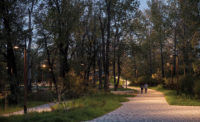Canadians refer to Georgian Bay as the sixth Great Lake. This appendage of Lake Huron is located almost due north of Toronto, and for many residents of that metropolis, Georgian Bay and its myriad small granite islands provide a summertime retreat. Modesty rules here, as many houses originally served as fishing huts and were hand-built.
“Hot water and a shower is heresy for Georgian Bay,” says one of the owners of an acre-and-a-half thimble known as Island 254c. For 40 years a small cottage stood in the center of this outcropping, hidden from the shoreline and its dramatic waterfront views to the west. Today it sports a pair of buildings designed by Toronto-based Peter Hamilton Architects that elegantly accommodates the owners’ getaway needs—including hot showers—without trumping the attitude or aesthetic of the region.
In profile, the five cedar-clad volumes that comprise the 2,000-square-foot main house may evoke the diagonal, shingled cottages of the Edward Larrabee Barnes–designed Haystack Mountain School of Crafts. The building also is reminiscent of low-slung houseboats or of 254c’s predecessor cottage, which was carefully dismantled and recycled. Another resemblance between old and new is more than skin deep: Never intended for wintertime occupancy, the new house, like the old one, foregoes insulation.
For Hamilton, however, the highly articulated main house represents not so much a reference to textbook or vernacular architecture history as a solution to a pressing riddle. The municipality in which Island 254c sits only allows construction of one building and one sleeping cabin on the property. (Boathouses are no longer permitted on the shoreline; 254c’s boathouse is grandfathered.)
Yet, without insulation, Hamilton explains, “you can hear through the walls. That’s why the sleeping cabins are connected at the corners. They appear separated without breaking the building code.” Like toy ducks connected on a string, the four sleeping cabins trail from the larger rectilinear volume that contains the kitchen and living and dining areas. Maple floors throughout were milled from century-old logs recovered from the bottom of Georgian Bay.
“You could have saved in the exterior envelope by making a single bar building,” Hamilton says, “but privacy and other livability issues would be compromised.” Constructing this illusion of a residential compound required no additional structural material, on the other hand. The sleeping cabins are built in a 16-inch balloon frame, while the public room features turned fir columns topped by steel moment connections bolted to timber beams and purlins. The entire structure is placed within a scoop of the glaciated rock that runs along a north-south axis, and is pinned to it for stability. Indeed, a recent tornado launched a nearby fishing cabin into the water, and there is a persistent wind that Hamilton hopes the homeowners will someday harvest with a windmill.
Even without a full outfit of green accoutrements, the homeowners—a married couple with six children and three grandkids—say the year-old residence is “in sync with the environment,” as the wife puts it. “I want to feel like my house is a verandah. I want to be looking out on the water and hearing it and watching incredible storms,” she says. In a more tangible nod to sustainability, each corner of the main house has a rain chain feeding a cistern that irrigates the vegetable garden.
The parti accommodates the homeowners’ brood nicely, too. “Each family has its own unit, deck, and view this way,” the wife says of the seemingly mutually exclusive sleeping cabins. “You can get away from everybody if you need to. And when you want to be with people, there’s the main cabin. There’s lots of opportunity to interact.” Besides sacrificing frugality for the exterior envelope, Hamilton also notes that island construction comes at a premium—more than twice what it would cost to build on the mainland. And the homeowner acknowledges, “We had many slash-and-burn sessions” as a result. Even so, the highest compliment? She says, “There were tons of things we took out, but it would be hard for me to remember what they were.”












Post a comment to this article
Report Abusive Comment